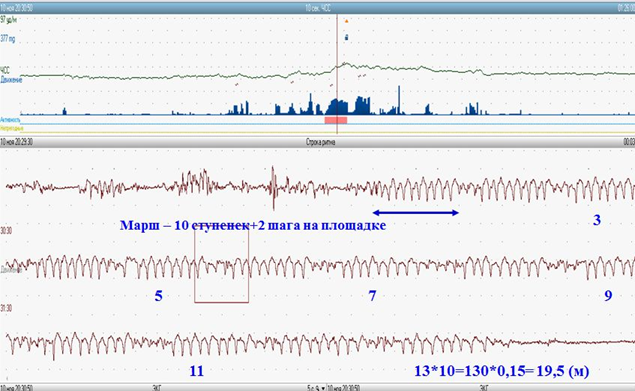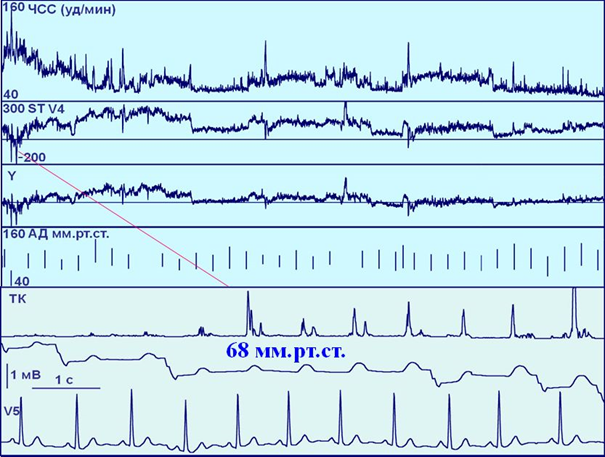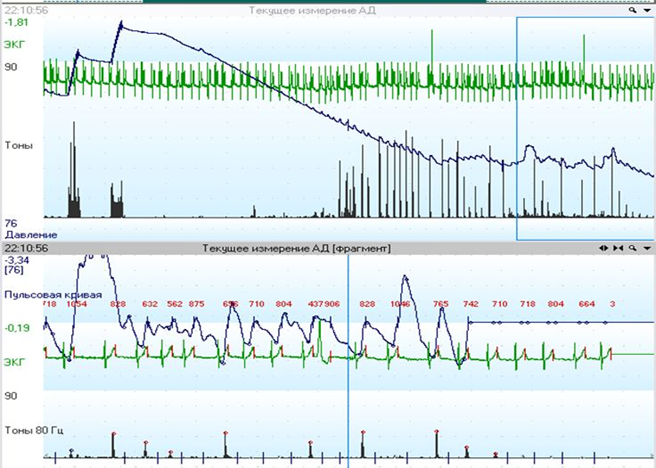Innovations and science
CARDIOTECHNICA monitoring and analysis systems are developed in collaboration with leading cardiologists and functional diagnosticians, opinion leaders in their fields.
Quality recording of pacemaker pulses
When using most Holter systems, it is warned that it is not possible to be guided by the value of implanted stimulator (IS) pulses, as their amplitude is unstable. This is especially true for imported stimulators with a very "narrow" pulse. In "Cardiotekhnika-07" monitors due to high frequency of analog-to-digital conversion it is possible not only to determine amplitude and polarity, but also to evaluate vector characteristics of ICs. This helps to determine the IC type (atrial or ventricular) in non-obvious and difficult cases. The new software even has a module that differentially diagnoses ventricular and atrial ICs based on their vector.

Unique accuracy of ECG analysis - arrhythmia detection, ST-segment displacement estimation, QT and PQ intervals determination
• On the websites of some manufacturers of Holter monitors you can see that the accuracy of detecting QRS-complexes and attributing them to ventricular or supraventricular reaches 99 - 99.5%, when checking according to the recommended GOST ECG databases. This seemingly high figure is insufficient for accurate analysis, as up to 100 thousand complexes are encountered during a day, and the error in selecting 0.5% of them will make it necessary for a long medical correction of errors (it will be necessary to correct the diagnosis in 500 cases). In "Cardiotechnika-07" system sensitivity and specificity of QRS-complexes selection reaches 99,99 %, i.e. errors can be only in 10 complexes per day.
• It is the only Holter monitoring system currently tested on the ICT Base (12 leads) recommended by the All-Union Scientific and Technical Committee (***) for testing monitors with 12 ECG leads. This base has achieved even higher accuracy of selection (up to 99.994%), which not only significantly increases the error-free diagnosis, but also significantly saves the time of the physician processing the Holter record.
Two sensors for physical activity and body position
• In the monitor and in the patient's cable electrode holder. Some pathologic conditions occur in only one body position, such as apnea on the back or arrhythmias on the left side. Until recently, it was impossible to assess the patient's body position during Holter monitoring, even if modern devices with built-in physical activity (PA) and body position sensor were used, because they detect movements quite well, but show the position of the monitor rather than the body position. The sensor in the patient cable solves this problem as it is always clearly fixed on the patient. In addition, the duplication of FA information allows for a more accurate assessment - it even becomes possible to count the number of steps on the stairs and determine the power of the load.

The accuracy of BP measurement is ensured:
• The use of two methods of BP measurement - Korotkoff and oscillometric, which can be done by less than half of BP monitor manufacturers. The Korotkoff method allows to obtain BP figures familiar to a doctor and to measure also while the patient is moving (even on a bicycle ergometer).
• The oscillometric method is used in patients with muffled tones and still allows BP monitoring in these patients. In addition, the combination of the two methods reduces the number of rejected measurements due to interference.
• The ability to verify any BP measurement by "uncovering" the primary signals (Korotkoff tones and cuff pressure). Based on the results of the analysis, it is possible to evaluate the correctness of the measurement and, if there are errors, to correct the BP figures or reject them.

• A unique feature is the estimation of systolic blood pressure (SBP) when the cuff is inflated. The BP measurement standard (***) requires that the cuff be inflated 30 mmHg above the CAD at this time. Failure to do so may result in "auscultatory failure" and errors in BP measurement. Until now, daily BP monitors could not meet this standard and estimate CAD when the cuff is inflated, and only in the monitor "Cardiotekhnika-07" it is realized due to a quiet compressor, special damping and special design of the microphone. Along with increasing the accuracy of BP measurement, this function increases the comfort of monitoring for the patient, as there is no excessively high pressure in the cuff.
Two leads of the rheopneumogram
• Thoracic and abdominal breathing are recorded, and there is no need to install any additional sensors to record them - the same electrodes used for ECG are used for the pneumogram. Comparison of the two curves increases the accuracy of breath analysis and detection of apnea in this screening method. In obstructive apnea, the phenomenon of "paradoxical breathing" can be detected, confirming the obstructive genesis of respiratory failure.

In central apnea, both thoracic and abdominal breathing can be seen to disappear (B), whereas in obstructive apnea, chest movements continue, but in the form of "paradoxical" breathing - in counter-phase to each other (A).
